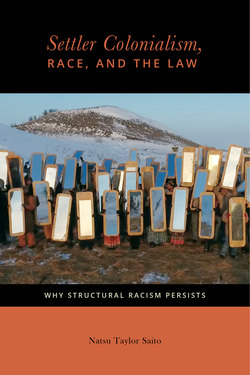Читать книгу Settler Colonialism, Race, and the Law - Natsu Taylor Saito - Страница 29
На сайте Литреса книга снята с продажи.
Colonialism and Genocide
ОглавлениеThe narrative presented in this book begins from the premise that, notwithstanding its insistent self-identification as a land of freedom and equality, the United States was established as a settler colonial state and—like Canada, Australia, New Zealand, and Israel—it remains one today.90 Patrick Wolfe’s insight that settler colonization is a structure rather than an event means that colonialism cannot be relegated to history. We live in a society whose most fundamental relationships have been, and largely continue to be, defined by the settlers’ goals of occupying the land, controlling its natural resources, rendering it profitable, and maintaining a social order reflective of their own priorities. In other words, we live within colonial (not postcolonial) economic, political, and social structures.91
Colonialism cannot function without perpetuating difference between the colonizers and the colonized; therefore, the social, political, or economic institutions of a colonial power cannot ultimately be made equitable. More fundamentally, colonialism is “by its nature” genocidal, as the philosopher Jean-Paul Sartre pointed out.92 This does not mean that it operates only by engaging in slaughter, although that certainly has happened and continues to happen. Raphael Lemkin, the Polish Jewish jurist who coined the term, wanted to clarify that it was criminal to “destroy, cripple, or degrade entire nations, racial and religious groups,” thereby eradicating their cultures and the contributions they had made or might make to humanity.93 Genocide thus encompasses a wide range of actions “committed with intent to destroy, in whole or in part, a national, ethnical, racial or religious group, as such,” to quote the 1948 Genocide Convention.94
In his seminal work, Axis Rule in Occupied Europe, Lemkin explained that “genocide has two phases: one, destruction of the national pattern of the oppressed group; the other, the imposition of the national pattern of the oppressor.”95 The latter, he noted, “may be made upon the oppressed population which is allowed to remain, or upon the territory alone, after the removal of the population and the colonization of the area by the oppressor’s own nationals.”96 Sartre observed that “colonialism cannot take place without systematically liquidating all the characteristics of the native society,” and this is why he concluded that it is intrinsically genocidal.97
The historical patterns of destruction and imposition identified by Lemkin are characteristic of American settler colonialism.98 As the following chapters illustrate, people of color have been racialized in ways that facilitate strategies intended to eliminate them, physically and conceptually, to exploit their labor, to contain and control them, and to force them into an assimilationist paradigm that nullifies their extant identities, thereby preempting them from exercising their inherent right to self-determination. This is why structural racism cannot and will not be eliminated if its colonial foundations are not recognized.
